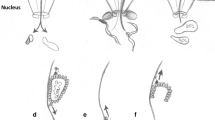Abstract:
The term nuclear transport, refers to the movement of a large variety of macromolecules both into and out of the nucleus. Transport must be extremely selective, yet also very efficient. A single type of channel, the nuclear pore complex, mediates all movement across the nuclear envelope. Selectivity is achieved through the use of families of soluble factors that target substrates for import and export and deliver them to their appropriate intracellular destinations. We now have a fairly detailed understanding of the basic mechanisms of protein import into the nucleus. Many of these same principles can be applied to protein export and perhaps RNA export. This review will summarize the current status of what is known about various transport pathways and highlight the questions that remain to be answered.
Similar content being viewed by others
Author information
Authors and Affiliations
Additional information
Rights and permissions
About this article
Cite this article
Quimby, B., Corbett, A. Nuclear transport mechanisms. CMLS, Cell. Mol. Life Sci. 58, 1766–1773 (2001). https://doi.org/10.1007/PL00000816
Issue Date:
DOI: https://doi.org/10.1007/PL00000816




